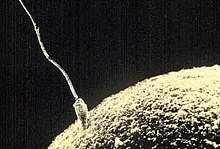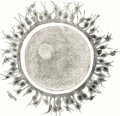I-ovum
I-ovum nge(siLatin: l"iqanda", isininzi: ziiova) ligama le-cell elibhekisa kwi-haploid eyimazi edalelwe ukuqhama ngokuthi izale, okanye i-gamete. zombini ezi zinto ziphilayo, izilwanyana kunye nezityalo kuthiwa z(ii-embryophytes) zivelisa imbewu ezi-ova.
Izilwanyana ezincancisayo
[tshintsha | Yenza izilungiso kokubhaliweyo]Abantu
[tshintsha | Yenza izilungiso kokubhaliweyo]
Ii-Ova zenziwa zii-ovaries zemazi zize ziphinde zikhutshwe kwazizo. Kwasekuzalweni kwakhe, umntu onesini sobufazi ubanawo onke amaqanda akhe. Uthi xa afikelela kwinqanaba lokufikisa apha ekukhuleni kwakhe, akhuphe iqanda libe linye ngenyanga de kungabikho qanda lishiyekileyo. Loo nto ke kuthiwa yi-oogenesis.
Xa i-ovum sele ichunyiswe nge-sperm sendoda, kuphuma i-zygote, ethi ikhule ibe sesinye isidalwa. I-ovum ichunyiswa ingaphakathi emzimbeni womntu ongumfazi, kutsho kuvele i-embryo ethi ikhulele ngaphakathi kweuterus, isondliwa yi-placenta kamama.
The ovum is the largest cell in the human body. You can see it without a microscope. The human ovum is between 100 and 200 µm long. They are nevertheless much smaller than the cleidoic eggs laid externally by reptiles and birds, which is why they need a long period of internal development in the womb.[1][2][3][4]
Ezinye izilwanyana ezincancisayo
[tshintsha | Yenza izilungiso kokubhaliweyo]The sexual cycle is quite different in other mammals, whose females are only receptive during their 'heat', which triggers the release of eggs from the ovary. Sexual activity then continues for a few days, then ceases entirely until the next heat.
Izityalo
[tshintsha | Yenza izilungiso kokubhaliweyo]In many plants, ova are made inside archegonia through meiosis. The archegonium has a long 'neck' with the egg cell inside. When the egg is mature, the neck opens and sperm swims in to fertilize the egg.
In flowering plants, the female gametes are made of only eight cells, called the embryo sac, inside the ovule. The cell closest to the opening of the embryo sac becomes the egg cell. When pollinated, sperm swims into the embryo sac and fertilizes the egg. The zygote then develops into an embryo inside the ovule.
Gallery
[tshintsha | Yenza izilungiso kokubhaliweyo]-
A human ovum
-
Sperm cells trying to fertilize an ovum
-
A sperm cell fusing with an ovum
Related pages
[tshintsha | Yenza izilungiso kokubhaliweyo]- ↑ "The Ovum, Gray's Anatomy of the Human Body, Yahoo! Education" archived from the original on 2009-07-25 retrieved 2015-10-26
- ↑ Ovum, Online Medical Dictionary, CancerWEB, Newcastle University
- ↑ "Oogenesis, Dr. Uzwiak, New Jersey State University" archived from the original on 2009-02-21 retrieved 2015-10-26
- ↑ Definition of Ovum, Biology-Online.org



